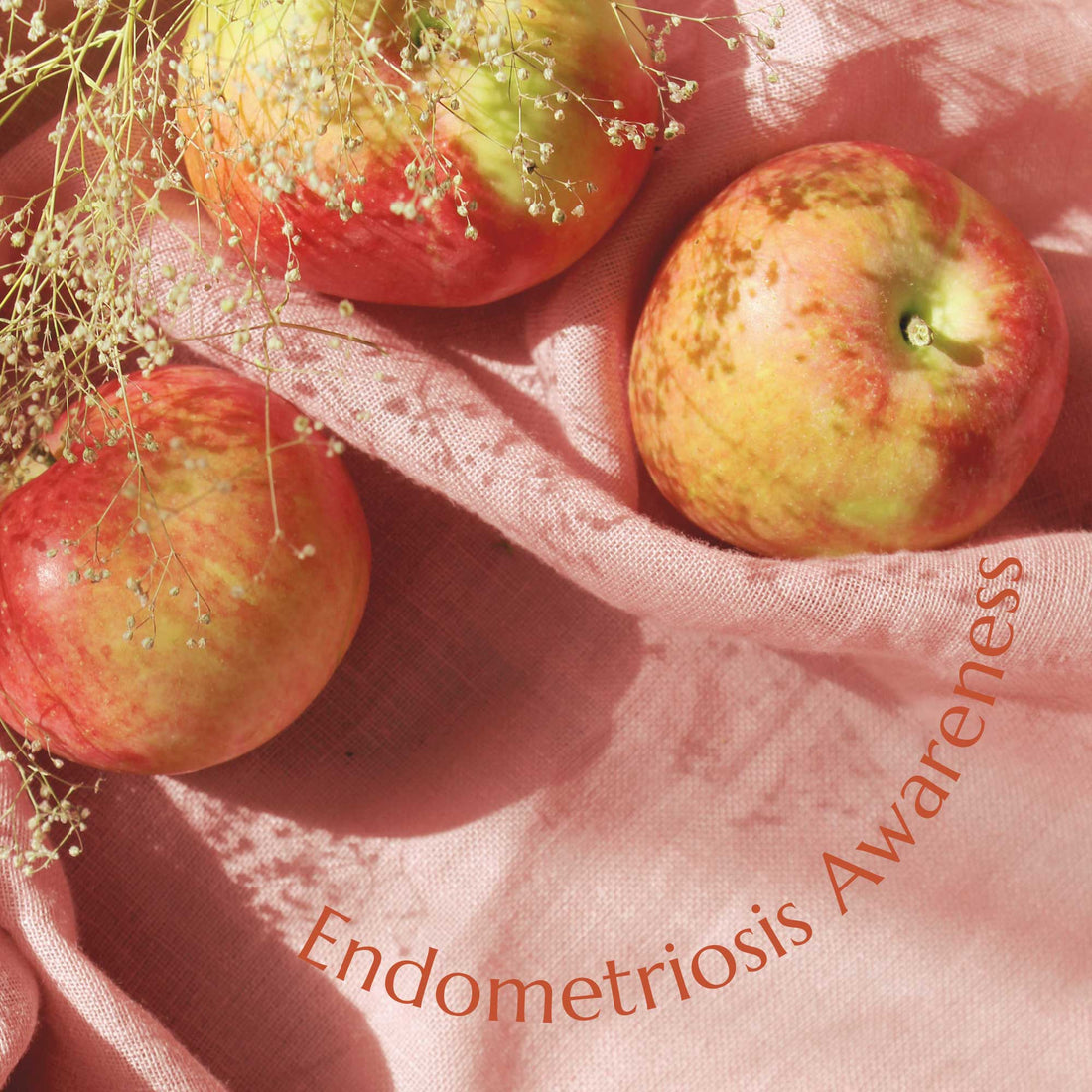This month in celebration of Endometriosis Awareness, we're partnering with the talented Jessica of This Endo Life to bring you all the helpful nutrition guidelines for those of us with endo.

Inflammation is a big topic these days. But for those of us living with endometriosis, it’s a really, really big topic.
Inflammation plays a major role in endometriosis and the way in which we experience symptoms. In the simplest of terms, endometriosis creates its own inflammation and encourages our body to up regulate inflammation too1.
Our immune system is constantly doing its best to fight endo off, but it’s not quite succeeding and so our body keeps sending inflammation and keeps attacking to no avail2. This cycle creates chronic inflammation, which as you guys are very well aware, is no fun.
Inflammation in small amounts is totally normal and is our body’s way of healing (think of the way skin will swell around a cut), but chronic inflammation is associated with various health issues including depression, disease and heightened pain.
In fact, people with endometriosis have been found to have higher levels of inflammation and oxidation in their bodies3. Oxidation is a process which causes cell damage and inflammation, so clearly we want less of that! We even have higher levels of pro-inflammatory hormone-like compounds called prostaglandin E2 in our peritoneal fluid4 – a liquid which lines our pelvic cavity and abdominal organs. And to top it all off, people with more painful periods have been shown to have higher levels of these inflammatory prostaglandins in their menstrual blood during their periods5.
So what can we do about it?
One of the core ways we can reduce inflammation is through an anti-inflammatory diet. Many diets can be anti-inflammatory, from paleo, to Mediterranean to vegan. The trend here is that they’re all rich in anti-oxidants from fruits, vegetables, herbs and spices.
To help you pull together your own anti-inflammatory diet, I’ve listed below some of the key foods to include when eating for endometriosis…
Vegetables and Fruits
Let’s start here! Vegetables and fruits play a significant role in reducing inflammation in our body, in fact, they’ve been associated with a reduced risk of endometriosis6 and have been shown to lower oxidation in people with endometriosis7.
Generally you want to be leaning towards more veggies than fruit, and aiming for 8-10 portions a day (think 2 portions of fruit and 8 portions of veggies).
Cruciferous veggies are particularly powerful for endometriosis, as they can help to eliminate excess oestrogen, which is common in people with endometriosis and can also drive endometriosis growth8.
Good fats
Yep. Fats get a mention here too. In particular, organic extra virgin olive oil, olives, avocados, coconut oil, meat or milk; nuts, seeds and of course, wild caught fatty fish.
Omega 3 fatty acids are particularly important as they’ve been found in multiple studies to reduce inflammation and have even been shown to reduce those pro-inflammatory prostaglandins during menstruation9 – which, you guessed it, means less pain.
Aim for about two portions of wild caught fatty fish a week, or if you don’t eat fish, make sure your diet is rich with eggs, walnuts, hemp seeds, chia and flax seeds, as these are all rich in omega 3 fats.
One thing to note is that if you’re vegan, unless you’re eating a truck load of algae, you probably won’t be getting enough of two very important types of omega 3 fats – DHA and EPA. Plant-based foods like walnuts are great sources of ALA, another type of omega 3 fats, but our bodies struggle to convert this into the anti-inflammatory forms of DHA and EPA. So, speak to a professional about trying some high quality vegan omega 3 supplements.
Nuts and seeds
Nuts and seeds are rich in nutrients that help our body to keep inflammation at bay, such as vitamin e10, zinc11 and magnesium12. If you can, soak your nuts and seeds as their outer layers contain protective enzymes, which mean we can absorb the nutrients as well. I then dehydrate mine in a dehydrator I bought from Amazon, you can get one for about £40.
Protein
Protein provides us with the essential nutrients we need for repair and neurotransmitter health. If we’re lacking in amino acids, which are what proteins are broken down into during digestion, we may find ourselves experiencing depression, anxiety and other cognitive problems, and may also find that our recovery post-surgery is slowed down. Being chronically inflamed can also worsen all of these issues too!
Ensuring we have some protein with each meal helps us to create stable blood sugar levels, which is incredibly important for healthy balanced hormones and reducing inflammation.
Protein can be a little tricky with endometriosis, as red meat has been associated with a higher risk of endometriosis13 and also carries some concerns around inflammation. Whilst some of my peers and clients feel better without red meat in their diet (including myself), others feel better with it and many experts suggest a moderate amount of organic, pasture-raised red meat is fine, and may even be helpful for supporting mood and reducing pain signals.
Where you get your protein from is down to your values and your body – if you choose to eat a vegan diet, ensure it’s rich in organic and soaked nuts, seeds, beans, legumes and gluten free whole grains like rice, quinoa and amaranth. You can also use vegan protein powders too!
If you find you feel better with some animal protein, make sure you’re getting in fatty fish as discussed above, and opt for organic and grass fed poultry, red meat and eggs to ensure that you’re not adding any extra hormones or toxins to your body.
Whole grains
Whole grains release energy over a sustained period of time, resulting in stable blood sugar levels – whereas refined carbohydrates or sugar rich foods cause blood sugar level spikes that can also trigger inflammation14. Whole grains are also rich anti-inflammatory nutrients such as B vitamins and antioxidants, and eating a diet rich in whole grains has been associated with lower levels of inflammation15.
However, you may find that gluten free grains are better for you – research has shown that eliminating gluten may reduce the pain associated with endometriosis16, and for some of us, gluten can cause inflammation in the gut, which could add to the systemic inflammation we often already have. Additionally, some of us are sensitive to grains, especially if we have leaky gut or other IBS issues, which could in turn worsen inflammation, so always eat foods that you feel benefit your body.
Herbs and spices
Herbs and spices are rich in antioxidants and plant compounds that reduce inflammation. They’ve also been shown to stimulate the production of digestive enzymes, which are essential to nutrient absorption17. As many of us with endometriosis suffer from IBS type symptoms, and chronic stress/fatigue/pain depletes stomach acid and digestive enzymes, having extra support can support us to absorb the nutrients we need to thrive with endometriosis.
Some of the most powerful (and delicious) spices are cinnamon18, ginger19 and turmeric20, all of which you can find in my Super Turmeric Latte!
___________________
If you’d like to learn more about managing and reducing your endometriosis symptoms, or would like support with making changes to do so, you can book in a free consultation call with Jessica to discuss your symptoms and challenges, and find out how her one-on-one endometriosis health coaching programme could help you. Jessica is currently offering £300 off her regular programme price in honour of Endometriosis Awareness Month, as well as single two-hour one off sessions throughout March. Head to her site to book in.
Jessica Duffin is a women’s health coach specialised in endometriosis. She is the founder of blog and podcast This EndoLife, and is a writer at Endometriosis Net and Endometriosis News.
__________________
- Sacco, K., Portelli, M., Pollacco, J., Schembri-Wismayer, P., & Calleja-Agius, J. (2011). The role of prostaglandin E2in endometriosis. Gynecological Endocrinology, 28(2), 134–138. doi: 10.3109/09513590.2011.588753
- Ahn, S. H., Monsanto, S. P., Miller, C., Singh, S. S., Thomas, R., & Tayade, C. (2015). Pathophysiology and Immune Dysfunction in Endometriosis. BioMed Research International, 2015, 1–12. doi: 10.1155/2015/795976
- Langendonckt, A. V., Casanas-Roux, F., & Donnez, J. (2002). Oxidative stress and peritoneal endometriosis. Fertility and Sterility, 77(5), 861–870. doi: 10.1016/s0015-0282(02)02959-x
- Peritoneal fluid volume, estrogen, progesterone, prostaglandin, and epidermal growth factor concentrations in patients with and without endometriosis. (1987). International Journal of Gynecology & Obstetrics, 25(2), 176–176. doi: 10.1016/0020-7292(87)90045-2
- Dawood, M. (1981). Dysmenorrhoea and Prostaglandins. Drugs, 22(1), 42–56. doi: 10.2165/00003495-198122010-00003
- Parazzini, F. (2004). Selected food intake and risk of endometriosis. Human Reproduction, 19(8), 1755–1759. doi: 10.1093/humrep/deh395
- Mier-Cabrera, J., Aburto-Soto, T., Burrola-Méndez, S., Jiménez-Zamudio, L., Tolentino, M. C., Casanueva, E., & Hernández-Guerrero, C. (2009). Women with endometriosis improved their peripheral antioxidant markers after the application of a high antioxidant diet. Reproductive Biology and Endocrinology, 7(1), 54. doi: 10.1186/1477-7827-7-54
- Kitawaki, J., Kado, N., Ishihara, H., Koshiba, H., Kitaoka, Y., & Honjo, H. (2002). Endometriosis: the pathophysiology as an estrogen-dependent disease. The Journal of Steroid Biochemistry and Molecular Biology, 83(1-5), 149–155. doi: 10.1016/s0960-0760(02)00260-1
- Rahbar, N., Asgharzadeh, N., & Ghorbani, R. (2012). Effect of omega-3 fatty acids on intensity of primary dysmenorrhea. International Journal of Gynecology & Obstetrics, 117(1), 45–47. doi: 10.1016/j.ijgo.2011.11.019
- Saboori, S., Shab-Bidar, S., Speakman, J. et al. Effect of vitamin E supplementation on serum C-reactive protein level: a meta-analysis of randomized controlled trials. Eur J Clin Nutr 69, 867–873 (2015). https://doi.org/10.1038/ejcn.2014.296
- Prasad, A. S. (2014). Zinc: An antioxidant and anti-inflammatory agent: Role of zinc in degenerative disorders of aging. Journal of Trace Elements in Medicine and Biology, 28(4), 364–371. doi: 10.1016/j.jtemb.2014.07.019
- Seifert, B., Wagler, P., Dartsch, S., Schmidt, U., & Nieder, J. (1989). Magnesium--a new therapeutic alternative in primary dysmenorrhea. Zentralbl Gynakol., 111(11), 755–760.
- Simmen, R. C. M., & Kelley, A. S. (2018). Seeing red: diet and endometriosis risk. Annals of Translational Medicine, 6(S2). doi: 10.21037/atm.2018.12.14
- Sun, Q., Li, J., & Gao, F. (2014). New insights into insulin: The anti-inflammatory effect and its clinical relevance. World Journal of Diabetes, 5(2), 89. doi: 10.4239/wjd.v5.i2.89
- Xu, Y., Wan, Q., Feng, J., Du, L., Li, K., & Zhou, Y. (2018). Whole grain diet reduces systemic inflammation. Medicine, 97(43). doi: 10.1097/md.0000000000012995
- Marziali, M & Venza, Marco & Lazzaro, S & Lazzaro, A & Micossi, Chiara & Stolfi, Vito. (2012). Gluten-free diet: A new strategy for management of painful endometriosis related symptoms?. Minerva chirurgica. 67. 499-504.
- Platel, K., & Srinivasan , K. (2004). Digestive stimulant action of spices: a myth or reality? Indian J Med Res, 119(5), 167–179. Retrieved from https://www.ncbi.nlm.nih.gov/pubmed/15218978
- Gunawardena, D., Karunaweera, N., Lee, S., Kooy, F. V. D., Harman, D. G., Raju, R., … Münch, G. (2015). Anti-inflammatory activity of cinnamon (C. zeylanicum and C. cassia) extracts – identification of E-cinnamaldehyde and o-methoxy cinnamaldehyde as the most potent bioactive compounds. Food & Function, 6(3), 910–919. doi: 10.1039/c4fo00680a
- Bernard, M., Furlong, S. J., Coombs, M. R. P., & Hoskin, D. W. (2015). Differential Inhibition of T Lymphocyte Proliferation and Cytokine Synthesis by [6]-Gingerol, [8]-Gingerol, and [10]-Gingerol. Phytotherapy Research, 29(11), 1707–1713. doi: 10.1002/ptr.5414
- Gupta, S. C., Patchva, S., & Aggarwal, B. B. (2012). Therapeutic Roles of Curcumin: Lessons Learned from Clinical Trials. The AAPS Journal, 15(1), 195–218. doi: 10.1208/s12248-012-9432-8


